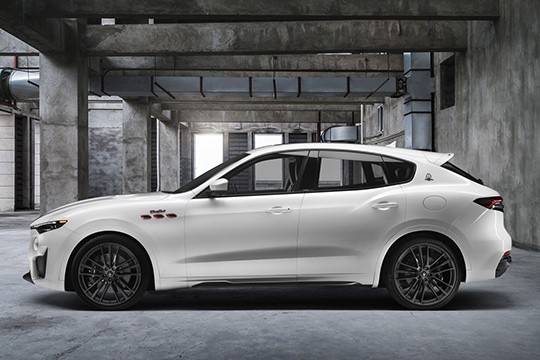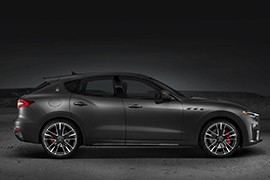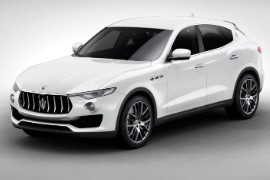MASERATI Levante Models/Series Timeline, Specifications & Photos
First production year: 2016
Engines: Gasoline, Hybrid gasoline, Diesel
Body style: SUV (Sports Utility Vehicle)
With the introduction of the Levante Trofeo, Maserati jumped to the necks of the German SUVs that had the M, the AMG, or the SQ badges on them.
2020 was a difficult year for all the world due to the world pandemic situation, but Maserati decided to launch online its main four-door contenders: the Ghibli, the Quattroporte, and the Levante with a twin-turbo V8 Ferrari engine. Unlike the other siblings, the Levante was the only one available with an all-wheel-drive system.
From the outside, the Levante didn't feature the same distinctive red trims as the Ghibli or the Quattroporte. It was more subtle, but some details could tell the difference. The front bumper and the rear apron were slightly modified. The wider air-intakes and the grille were specific for the Levante Trofeo.
Inside, the Levante featured carbon fiber trims and, as an option, it could have been fitted with carbon-fiber paddle-shifters placed behind the steering wheel. On the center console, there was the gear selector and the buttons for the driving modes. The instrument cluster and the infotainment display were the same as on the Maserati Levante GTS. The carbon fiber trims were seen on the center console, the center stack, and on the dashboard as well. For the front occupants, a pair of bucket seats were installed.
But the real update was on the technological side. A 3.8-liter V8 engine was placed under the hood and paired to an 8-speed automatic transmission. Power went in all four corners. For better control of the 580 hp, the Quattroporte Trofeo was fitted with an Integrated Vehicle Control (IVC) system, tuned for enhanced vehicle dynamics, and better active safety.
The Maserati Levante was the first SUV built by the Italian car manufacturer. Even if it was related to the Alfa Romeo Stelvio, it featured a different style. And, in the Trofeo special edition, it was more exclusive.
The market demanded SUVs, so most of the brands had something to offer in the segment. The first supercar company that made an SUV was Porsche with the Cayenne, a car that was hated by the purists and then bought by purists. The same happened with the Alfa Romeo and Maserati. Two brands linked by inside the same group under the Fiat umbrella.
The Trofeo version was introduced in 2018 as a top model for the exclusive premium Italian brand. It featured the largest wheels ever installed on a Maserati to date. With their 22” diameter, the specially designed set offered better grip and a firmer ride. The black front grille differentiates the Trofeo version from the rest of the range. On the D-pillars, inside the Maserati trident badge, the word TROFEO was included. Otherwise, it was very hard to differentiate the special edition from the lesser version of the Levante.
Maserati was often criticized for some plastic parts inside its cabin for a car of its price. The Trofeo fixed that with carbon-fiber elements on the center console and on the dashboard. Moreover, these elements were not covered with enamel polish but they were left bare and rough. But they looked great just like that. The special leather interior, with hand stitches, improved the luxurious look of the car.
Under the hood, the Trofeo was offered with a 3.8-liter Twin Turbo V8 engine that was engineered to perfectly mate with the Q4 Intelligent All-Wheel Drive System. Like all the other Maserati engines, this one was built by Ferrari at Maranello.
Maserati stirred the market with the introduction of its first SUV in history, a car that breached into a world dominated by other premium automakers thanks to its Ferrari-sourced engines and the sports car lines of bodywork.
It was clearly not just another SUV on the market, one that could only be used for school runs and pull trailers with boats attached to it. The Levante was Maserati's alternative for go-fast SUVs that could keep pace with sports cars and still be able to transport a family of four in comfort. In addition, the vehicle attracted more customers to the Italian brand thanks to its look, performance, and usability. It was no longer a sports car for two but one that the owners could share with their families and friends.
Maserati made the Levante on the same platform as the Ghibli and the Quattroporte and unveiled the SUV in 2016 at the Geneva Motor Show. At the front, the car featured a large grille dominated by vertical slats where the “Tridento” badge took center stage. Unlike most SUVs, the car featured slim headlights compared to the rest of the front fascia and featured an additional set of fog lamps underneath them. On the lower side of the bumper, the automaker added a broad air intake with a hexagonal pattern for the mesh. In addition, Maserati placed a light-gray trim underneath the bumper and engine compartment that mimicked an underbody shield.
The luxurious interior featured broad areas covered in leather. Besides the seats and door cards, the dashboard was trimmed with the same material and matching color. Depending on the engine version, grades, and options, the Levante boasted carbon fiber trims or wood grains. The instrument cluster fronted the driver and featured two large dials for the speedometer and tachometer that flanked an LCD. To complete the technology package, Maserati installed an 8.4” touchscreen on the center stack between two slim vertical vents. The high-bolstered front seats were separated by a tall center console that featured the armrest and housed the gear selector and the controller for driving modes. Under the armrest, the automaker installed a storage compartment. In the back, the Levante featured a bench for three adults but mostly profiled for two. In addition, the split-folding seatback could expand the trunk space.
Under the hood, Maserati installed a choice of gasoline-powered V6 and V8 engines developed by Ferrari. Furthermore, for specific markets, the carmaker offered a turbo-diesel version. All versions were paired with an eight-speed automatic transmission that sent the power to all corners. A torque-vectoring all-wheel-drive system and an adaptive suspension enhanced the car's on-road behavior. While the automaker didn't make the Levante to conquer remote places on top of a mountain, it still made the vehicle good enough to tackle unpaved roads and perform well in snow-covered areas.


